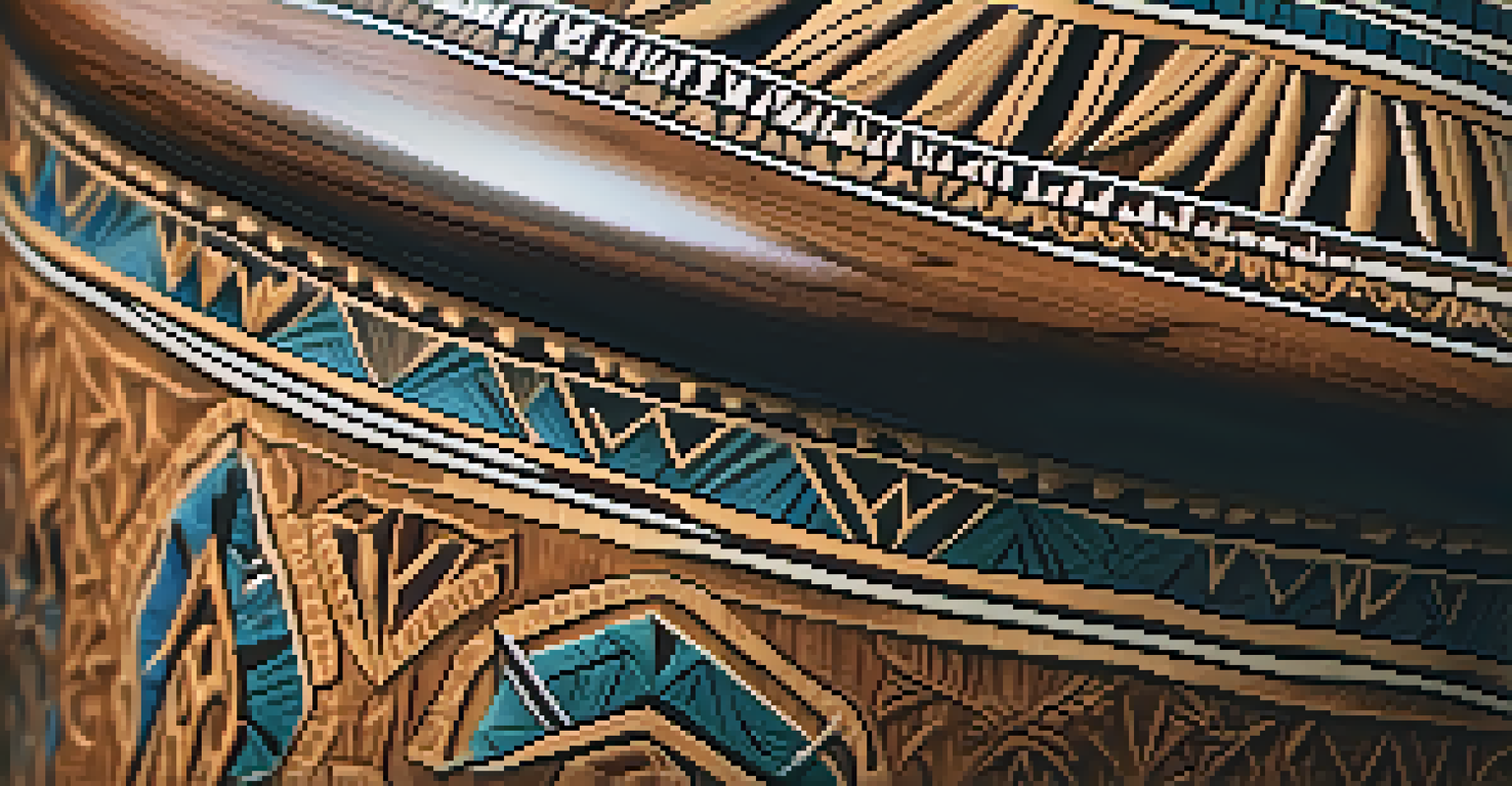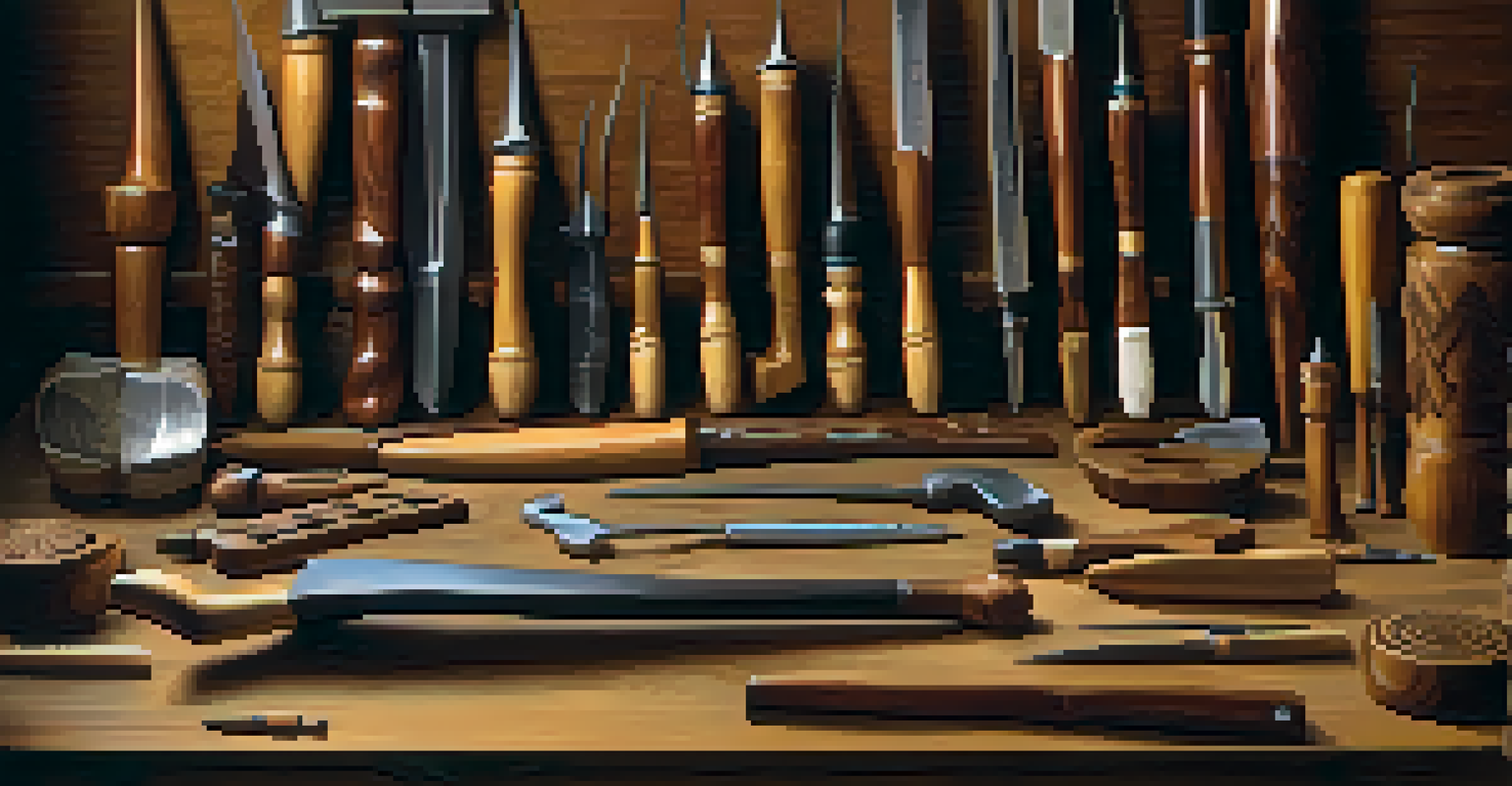Techniques in Carving: Traditional Methods for Musical Art

Understanding the Art of Carving in Music
Carving has long been an essential technique in crafting musical instruments, where each cut and shape contributes to the instrument's sound quality. This artistic process blends both functionality and aesthetic appeal, making it a crucial skill for luthiers and artisans alike. Traditionally, materials like wood are favored for their acoustic properties, further emphasizing the importance of the carving technique in the musical realm.
The beauty of music is that it transcends the boundaries of culture and time, much like the intricate designs carved into the instruments that create it.
Historically, these methods have been passed down through generations, often unique to specific cultures or regions. For instance, the intricate carvings found on traditional African drums not only serve a decorative purpose but also enhance the instrument's resonance. Understanding these nuances adds depth to the appreciation of musical craftsmanship.
As we delve deeper into the various carving techniques, we’ll see how they impact not just the look of the instrument but also its playability and sound. Each method has its own set of challenges and rewards, making the journey of learning to carve both an art and a science.
Basic Tools for Traditional Carving Techniques
To begin carving musical instruments, having the right tools is essential. Traditional carvers often use chisels, gouges, and knives, each designed for specific cuts and details. These tools allow artisans to create intricate designs and precise shapes that contribute to the final sound of the instrument.

Each tool has its own unique purpose; for example, chisels are ideal for making clean, straight cuts, while gouges are perfect for hollowing out areas or creating curves. As you become more familiar with these tools, you'll learn how to choose the right one for your specific carving needs. This knowledge is key to developing your skills as a carver.
Carving Shapes Sound Quality
The art of carving musical instruments directly influences their sound quality and playability, blending both functionality and aesthetic appeal.
Investing in quality tools can make a significant difference in your carving experience. Just like a musician selects the best instrument for their craft, a carver should choose tools that feel comfortable and efficient in their hands.
The Role of Wood Selection in Carving Techniques
Wood selection is paramount in traditional carving, as different types of wood offer varying densities, textures, and tonal qualities. For example, mahogany is favored for its warm sound, while spruce is often used for its bright, resonant quality. Understanding the characteristics of each wood type can help you choose the best material for your musical creation.
Art is not what you see, but what you make others see. The carvings on an instrument tell a story that goes beyond sound.
Moreover, the age and condition of the wood also play a significant role in the carving process. Older woods may have unique grains or imperfections that can add character to the finished product. Embracing these natural features can lead to distinctive instruments that tell a story.
As you explore different woods, consider experimenting with various finishes and treatments to enhance their natural beauty. This not only improves the aesthetic appeal but can also influence the instrument's sound, further showcasing the importance of wood selection in carving.
Exploring Traditional Carving Techniques: Step-by-Step
One of the most fascinating aspects of traditional carving is the meticulous step-by-step process that artisans follow. Starting with a rough outline, carvers gradually refine their work, focusing on the details that make each piece unique. This journey often involves multiple stages, including shaping, hollowing, and detailing.
For instance, when carving a wooden flute, you might begin by roughing out the body before carefully shaping the tone holes. Each decision made during this process affects the instrument's final sound, requiring a blend of artistry and technical skill. Patience and practice are essential, as mastering these techniques takes time and dedication.
Wood Selection Matters
Choosing the right type of wood is crucial, as each variety offers unique tonal qualities and characteristics that affect the final instrument.
Documenting your process can be incredibly valuable, not only for your development but also for sharing your journey with others. Whether through videos or written notes, capturing your steps allows you to reflect on your growth as a carver and musician.
Incorporating Decorative Elements in Carving
Decorative elements can elevate a musical instrument from functional to extraordinary. Traditional carvings often feature intricate patterns, motifs, and symbols that reflect cultural heritage and personal expression. Adding these details not only enhances the visual appeal but can also imbue the instrument with deeper meaning.
For example, many Native American flutes are adorned with carvings that represent natural elements or spiritual beliefs. This connection to culture and history enriches the instrument’s story, making it more than just a tool for music. When carving, consider how you can incorporate such elements to express your individuality.
However, balance is key; too much decoration can overwhelm the instrument's natural beauty. Finding a harmonious blend between functionality and artistry is what makes traditional carving truly special.
Finishing Techniques to Enhance Musical Carvings
Once the carving is complete, the finishing touches are essential for protecting and enhancing the wood. Techniques such as sanding, oiling, and lacquering can bring out the wood's natural grain while providing a protective layer. These steps are crucial for ensuring the durability of the instrument and maintaining its beauty over time.
Sanding, for example, smooths out any rough edges and prepares the surface for oil or lacquer. This process not only improves the aesthetic but also affects the instrument's sound quality. A well-finished instrument can resonate better, making it more enjoyable to play.
Preserving Carving Traditions
It's essential to preserve traditional carving techniques through education and community engagement to ensure the craft continues for future generations.
Experimenting with different finishes can also yield unique results, as each type affects the wood's appearance and sound differently. By understanding these finishing techniques, you can truly elevate your musical creations.
Preserving Traditional Carving Techniques for Future Generations
As traditional carving techniques face the risk of fading into obscurity, it’s vital to preserve and pass down these skills. Workshops, online tutorials, and community classes offer opportunities for aspiring carvers to learn from seasoned artisans. Emphasizing the importance of mentorship can keep these traditions alive for future generations.
Moreover, sharing knowledge through social media platforms allows for a broader reach, connecting enthusiasts from around the world. This not only helps preserve the craft but also fosters a sense of community among those passionate about musical artistry. Engaging with a global audience can inspire new ideas and techniques.

Encouraging collaboration among artisans can lead to innovative approaches that honor traditional methods while incorporating modern influences. By valuing both the past and the present, we can ensure that the art of carving musical instruments continues to thrive.